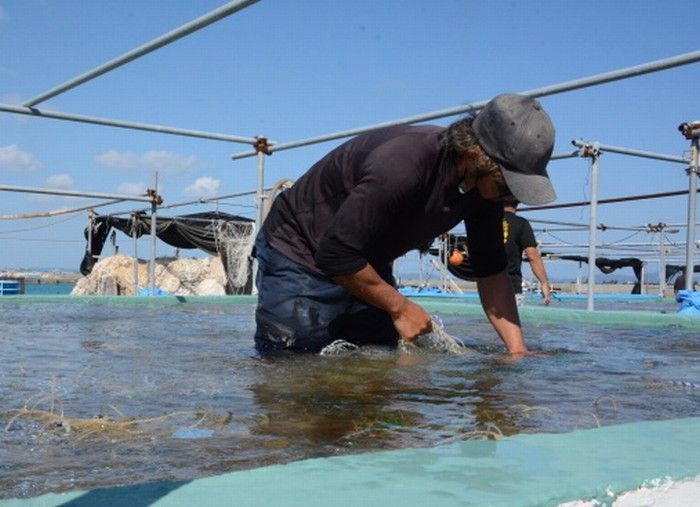Mozuku aquaculture interrupted by pumice stones, expected to effect national supply

A man working at a mozuku tank, unable to travel to the fishing area. Usually, the mozuku is placed in the ocean around two weeks after the end of the mating period – October 28 Hama Fishing Harbor in Katsuren, Uruma
October 29, 2021 Ryukyu Shimpo
Uruma; Nanjo – The large amounts of pumice stone floating in the waters around Okinawa are continuing to cause damage throughout the prefecture. It has caused a hindrance to the prefecture’s aquaculture of mozuku, an edible seaweed, and it was learned on October 28 that it has caused the death of 500 farm-raised cobia fish in Ikemi Fish Harbor. The Okinawa Ministry for Agriculture, Forestry and Fisheries announced the same day that work to remove the influx of pumice stone from Hentona Harbor in Kunigami would commence on October 29. In most years for Uruma mozuku aquaculture, mating us usually wrapping up at the end of October, and workers are beginning to lay nets in the water, however since the boats cannot leave the harbor the work has been delayed. It is an ominous indicator for the targeted harvest in February. 99% of Japan’s mozuku is produced in Okinawa, so there is a fear that the effects of this damage will spread throughout the country.
The largest producer of mozuku is in Katsuren, Uruma. Around 40% of the mozuku produced in Okinawa happens there. Many fishermen could be seen on October 28 at the tightly packed mozuku tanks at Hama Fishing Harbor. “Up until now, when we went out into the ocean there was no one here,” said Katsuren Fishing Cooperative Shore Division head Tadahito Uemura, letting out a sigh.
Already 11 tons of pumice has been removed, and removal continued on the 27th, but on the morning of the 28th more stones could be seen floating in the harbor. Previously, after setting the nets workers would check on the mozuku each day to watch its growth. However, since they cannot leave the port Uemura lamented, “If this situation continues like this, we will not be able to ship [the harvest].”
There is also trouble at Okinawa’s second-largest mozuku producing area in Nanjo. A fisherman, 44, at Shikiya Harbor makes his way to the aquaculture area while trying to avoid the pumice floating in the water. The placing of the nets after mating is usually done with the engines kept running. However, since the pumice gets into the filter used to keep the engine from overheating, diving has been suspended, and they need to remove the pumice every 10 minutes. “We are unable to work calmly,” said the fisherman, unable to hide his exhaustion. Another fisherman commented, “If we can’t harvest the mozuku, we can’t make a living,” and asked for assistance from the Japanese and Okinawan governments.
According to the Okianwa Mozuku Aquaculture Promotion Committee, 2021 production of mozuku was 19,278 tons. The Katsuren Cooperative produced the most at 8,299 tons, with the Chinen Cooperative coming next at 3,148 tons.
(English translation by T&CT and Sam Grieb)
Previous Article:Tokashiki celebrates two local women turning 97: Their secret to long life? – Farming
Next Article:Governor Tamaki says Okinawa to rescind shortened business hours at the end of October
[Similar Articles]
- Large amounts of fish are killed after swallowing pumice stones from undersea volcanic eruption, 14 Okinawan fisheries reeling from the damage as Okinawa and Japan coordinate on removal
- Mozuku harvest begins in Miyakojima, yielding “thick, high quality seaweed, a prime result”
- “It looks like reclaimed land” as floating pumice inundates the coast of Motobu
- Large eel appears on road
- Okinawan Mozuku, and edible seaweed, is struggling with poor harvests, leading to an increase in price and 6,000 ton decrease in production
 Webcam(Kokusai Street)
Webcam(Kokusai Street)


